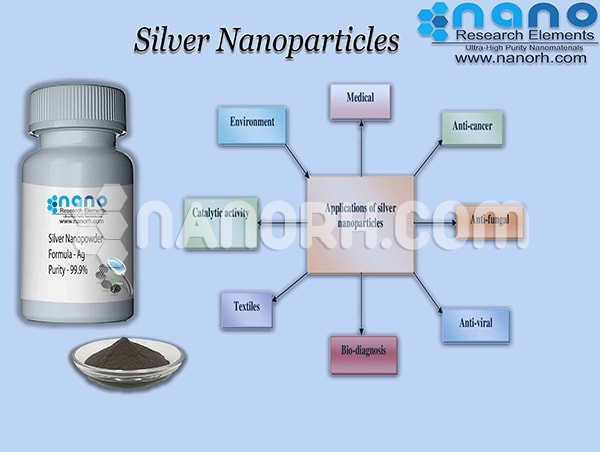SILVER NANOPARTICLES
SILVER NANOPARTICLES (Au NPs)
INTRODUCTION
Silver is a significant extraordinary component. It has the most astounding warm and electrical conductivity everything being equal. As a respectable metal, it is extremely consumption safe. All things considered, it is more receptive than gold or platinum.
Reactivity and furthermore conductivity include surface impacts. These are particularly intriguing on the nano-scale when measurements of the silver turned out to be to a great degree little and the surface-to-volume proportion increments unequivocally. The subsequent impacts and applications are complex and have filled logical books.
One of these impacts: nano-silver assimilates light at a trademark wavelength (because of metallic surface Plasmon's), which prompts a yellow shading. This was first connected in the shading of dishes many years prior. Without knowing the reasons, individuals crushed silver and gold to the nano-scale to give church windows changeless, non-blurring yellow and red shading.
Today, the consistent change of techniques for the generation and portrayal of nanoparticles enables us to more readily comprehend and use nanotechnology. As respects, optical properties, the installing of nano-silver and nanoparticles from different metals in straightforward materials can be tuned to make optical channels that work based on nanoparticles assimilation.
Notwithstanding, the most important normal for nano-silver is its compound reactivity. This prompts an antimicrobial impact of silver that depends on solid bonds between silver particles and gatherings containing carbon monoxide, carbon dioxide, or oxygen, which keeps the spreading of microscopic organisms or parasites. Nano-silver gives an extensive number of surface particles for such antibacterial collaboration. This has prompted numerous restorative utilizations of nano-silver, for example, in catheters or wound dressings. In the meantime, there are even numerous shopper items available that contain nano-silver, which has incompletely raised doubt with respect to item security.
Another utilization of nano-silver that is as of now settled: conductive nano-inks with high filling degrees are utilized to print profoundly exact persistent conductive ways on polymers. It is trusted that later on; nano-silver will empower the further scaling down of hardware and lab-on-a-chip innovations.
In spite of the fact that these applications "basically" make utilization of little molecule sizes, there are complex approaches to create such silver nanoparticles - and altogether different properties and characteristics of these materials. Consider creation of nano-silver has been connected for in excess of a hundred years; however, there are indications that nano-silver has even dependably existed in nature.
Gas stage science produces silver-based powders in substantial sums that frequently comprise of silver oxide (without a run of the mill metallic properties) and don't generally comprise of discrete particles. This permits the utilization in mass items, however not in superb applications that require homogeneous conveyances or fine structures.
Colloidal science produces nano-silver scattered in fluids. Different responses can integrate nano-silver. Nonetheless, synthetic stabilizers, saving operators, and rests of compound forerunners make it hard to utilize these colloids in organic applications that require high immaculateness.
At last, new physical strategies even permit the creation of nano-silver scatterings without compound contaminants, and even specifically in solvents other than water. This field is driven by laser removal, empowering to produce fluid scattered nano-silver that exceeds expectations by the biggest quality and assorted variety.
With this propelling assortment of strategies for the creation of nano-silver, its applications are in like manner expanding - making nano-silver increasingly well known as an advanced item refinement material.
BIOMEDICAL APPLICATIONS OF SILVER NANOPARTICLES
Because of their one of kind properties, AgNPs have been utilized broadly in household utensils, the social insurance industry, and in sustenance stockpiling, natural, and biomedical applications. A few surveys and book parts have been devoted to different regions of the use of AgNPs. In this, we are keen on underscoring the uses of AgNPs in different natural and biomedical applications, for example, antibacterial, antifungal, antiviral, mitigating, hostile to disease, and against angiogenic.
DIAGNOSTIC, BIOSENSOR, AND GENE THERAPY APPLICATIONS OF SILVER NANOPARTICLES
The headway in therapeutic advancements is expanding. There is much enthusiasm for utilizing nanoparticles to enhance or supplant the present treatments. Nanoparticles have points of interest over the present treatments since they can be designed to have certain properties or to carry on absolutely. Ongoing improvements in nanotechnology are the utilization of nanoparticles in the advancement of new and successful medicinal diagnostics and medications. The capacity of AgNPs in cell imaging in vivo could be exceptionally helpful for considering irritation, tumors, resistant reaction, and the impacts of immature microorganism treatment, in which differentiate specialists were conjugated or embodied to nanoparticles through surface adjustment and bioconjugation of the nanoparticles.
Silver assumes a vital job in imaging frameworks due to its more grounded and more honed Plasmon reverberation. AgNPs, because of their littler size, are primarily utilized in diagnostics, treatment, and in addition consolidated treatment and analytic methodologies by expanding the acoustic reflectivity, at last prompting an expansion in brilliance and the production of a clearer picture. Nanosilver has been seriously utilized in a few applications, including finding and treatment of growth and as medication transporters. Nanosilver was utilized in a blend with vanadium oxide in battery cell parts to enhance the battery execution in cutting-edge dynamic implantable medicinal gadgets.

